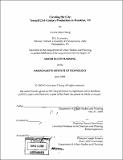| dc.contributor.advisor | Dennis Frenchman. | en_US |
| dc.contributor.author | Chung, Connie Jean | en_US |
| dc.contributor.other | Massachusetts Institute of Technology. Dept. of Urban Studies and Planning. | en_US |
| dc.coverage.spatial | n-us-ny | en_US |
| dc.date.accessioned | 2009-11-06T16:20:10Z | |
| dc.date.available | 2009-11-06T16:20:10Z | |
| dc.date.copyright | 2009 | en_US |
| dc.date.issued | 2009 | en_US |
| dc.identifier.uri | http://hdl.handle.net/1721.1/49688 | |
| dc.description | Thesis (M.C.P.)--Massachusetts Institute of Technology, Dept. of Urban Studies and Planning, 2009. | en_US |
| dc.description | Includes bibliographical references. | en_US |
| dc.description.abstract | In the past decade, the creative city discourse has pulsated with activity, with academics, policy wonks, national organizations, and community non-profits attempting to find footholds in the conversation. By applying the lessons of 20th-century industrial complexes, or "technopoles," to a new conception of production in the 21st century, city builders, planners, and business developers tackle the new role of fitting the commercial creative sector into Castells's 'networks' and this creative city discourse, in order to generate innovation in the creative city. The thesis aims to closely examine the role that for-profit creative production now plays in the 21st century urban economic engine and the ways in which synergy may be created by and among many individual creative firms in the city. The thesis uses the borough of Brooklyn, in New York City, as a case and example of how to go about supporting new kinds of urban creative clusters. The thesis proposes principles, guidelines, and an approach to cluster development, not as a universal solution for currently uncoordinated clustering, but as a place-based example for applying the principles of this thesis. I will review the evolution of 21st-century production and the emergence of the creative economy, including the case for locating creative production centers in metropolitan locales, in order to illustrate the shape of the new production landscape in the creative city. | en_US |
| dc.description.abstract | (cont.) I next present a framework for organizing and developing a 21st-century creative cluster, and outline fourteen key ingredients to their development. Finally, I apply this framework to a creative-cluster development strategy in Brooklyn, identifying three possible areas of intervention where creative firms already operate, and propose a public-private management entity structure to provide the necessary synergistic 'glue.' | en_US |
| dc.description.statementofresponsibility | by Connie Jean Chung. | en_US |
| dc.format.extent | 65 p. | en_US |
| dc.language.iso | eng | en_US |
| dc.publisher | Massachusetts Institute of Technology | en_US |
| dc.rights | M.I.T. theses are protected by
copyright. They may be viewed from this source for any purpose, but
reproduction or distribution in any format is prohibited without written
permission. See provided URL for inquiries about permission. | en_US |
| dc.rights.uri | http://dspace.mit.edu/handle/1721.1/7582 | en_US |
| dc.subject | Urban Studies and Planning. | en_US |
| dc.title | Creating the city : toward 21st-century production in Brooklyn, NY | en_US |
| dc.type | Thesis | en_US |
| dc.description.degree | M.C.P. | en_US |
| dc.contributor.department | Massachusetts Institute of Technology. Department of Urban Studies and Planning | |
| dc.identifier.oclc | 436224372 | en_US |
